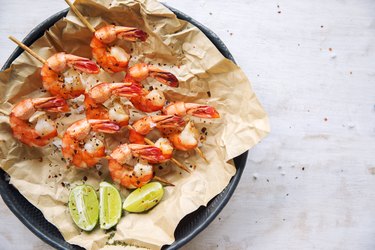
When you think of shrimp, chances are you don't think about using a whole shrimp recipe. Cooking tiger prawns isn't as intimidating as it sounds. If you find a tiger prawns recipe with shell on, there are several delicious ways to prepare it.
What Are Tiger Prawns?
Video of the Day
Also known as tiger shrimp, the Texas Invasive Species Institute says these creatures can grow to be a foot long and weigh about a pound. Tiger prawns get their name from the fact that they have black or orange stripes and a black or orange body that resembles a tiger.
Video of the Day
Native to the Indian Ocean, they can also be found in the Gulf of Mexico, Texas, Alabama, Florida, Louisiana, Mississippi, Georgia, and North and South Carolina.
According to the USDA, a 3-ounce serving of tiger shrimp contains 120 calories, 23 grams of protein, 2 grams of fat and 1 gram of carbohydrates. A serving contains 188 milligrams of sodium.
The 2015-2020 Dietary Guidelines for Americans suggests consuming no more than 2,300 milligrams of sodium per day. According to the Centers for Disease Control and Prevention, eating too much sodium increases your risk for high blood pressure, stroke and heart disease.
Read more: Do Prawns Make a Healthy Meal?
Cooking Tiger Prawns
If you've never cooked a whole shrimp recipe before, it may be a bit intimidating. However, you're not limited to a single method when it comes to cooking tiger prawns. You can boil them, sauté them or grill them.
You can cook them from frozen too, if you rinse them in cool water to remove debris before cooking. Though it increases cooking time slightly, it's a good option if you don't have time to thaw them first.
When it comes to boiling a whole shrimp recipe, the Florida Department of Agriculture and Consumer Services says all you have to do is make sure there's enough water to completely cover all the prawns. Season the water as desired and bring to a boil.
Add shrimp once the water is boiling and reduce the heat to a simmer. Continue to cook until the shrimp are pink and opaque. Cooking time varies depending on the size, so large prawns will take longer, but generally only takes a few minutes. Drain and serve.
To sauté any tiger prawns recipe with shell on, cook over high heat, with a bit of butter or olive oil. You can add other ingredients such as garlic for additional flavor.
To ensure the prawns cook evenly, spread them out in a single layer on the pan. Sear for one to two minutes. You may initially see they stick to the pan, but after the exterior sears they will release from the pan.
When you are able to move the prawns around easily, flip them over to sear the opposite side. They're cooked when the thickest part of the prawn, the end opposite the tail, has turned opaque. Remove from heat immediately, as heat from the pan will continue to cook the prawns. Serve as desired.
To grill your tiger prawns recipe with shell on, you'll want to use the same hot and fast method you would if sautéing them on the stove. Heat the grill. While waiting for the grill to get hot, coat your prawns in olive oil and season as desired. Arrange the prawns on the grill in a single layer and cook for one to two minutes or until they naturally release from the grill.
Flip to cook the other side and cook until the thickest part of the prawn is opaque. Remove from heat immediately and serve as desired.
Read more: The 9 Safest Seafood Options
Benefits of Eating Prawns
Prawns offer a great source of lean protein. And for those who wonder if they're better for you than shrimp, a July 2016 study published in Cogent Food & Agriculture found the nutritional composition of pink shrimp and tiger shrimp was statistically insignificant. Both are low in potassium.
If your doctor has suggested a low sodium diet for any reason, the American Heart Association says you should aim to consume no more than 1,500 milligrams of sodium per day. Eating shrimp as part of a healthy diet means reducing salt from other sources to stay within those guidelines.
The National Institutes of Health also says shrimp is a good source of iodine. According to a March 2014 study published in the Annals of Pediatric Endocrinology & Metabolism, both iodine excess and iodine deficiency increase the risk of thyroid disorders.
More research is needed to determine the optimal range of iodine intake and to clarify the effects of intake levels on various thyroid disorders. Because wild-caught prawns can contain high levels of environmental toxins, it's best to opt for farm raised due to the effects on the body.
- Texas Invasive Species Institute: "Giant Tiger Prawn"
- USDA: "Black Tiger Shrimp"
- Health.gov: "Dietary Guidelines for Americans, 2015-2020: Shifts Needed to Align With Healthy Eating Patterns"
- Cogent Food & Agriculture: "Comparative Study on the Nutritional Composition of the Pink Shrimp (Penaeus notialis) and Tiger Shrimp (Penaeus monodon) from Lagos lagoon, Southwest Nigeria
- National Institutes of Health: "Iodine"
- Annals of Pediatric Endocrinology & Metabolism: "Iodine and Thyroid Function"
- Florida Department of Agriculture and Consumer Services: "Wild Shrimp"
- American Heart Association: "How Much Sodium Should I Eat Per Day?"